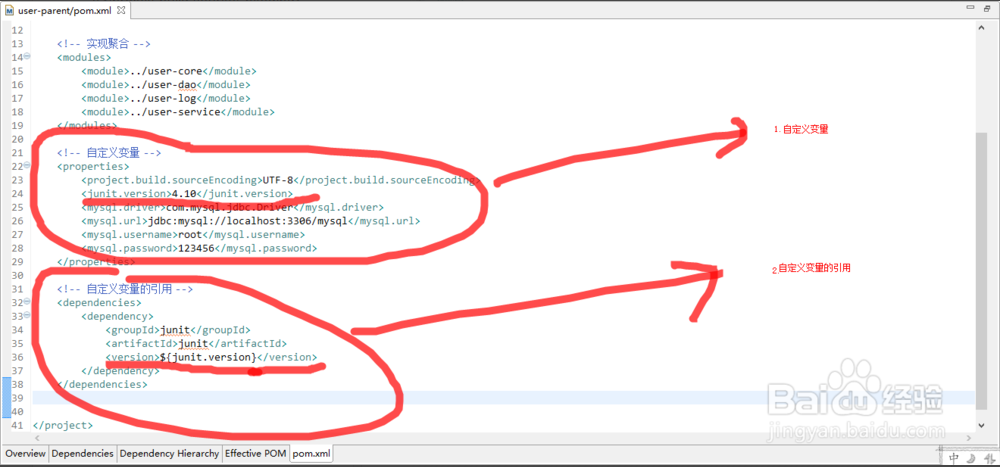maven是一个项目构建和管理的工具。
我们可以通过maven仓库可以实现管理构建(主要是JAR还包括:WAR,ZIP,POM等等)。
我们可以通过maven插件可以实现编译源代、产生Javadoc文、运行unit测试、生成站点等等功能。
maven通过分模块开发提升效率。
工具/原料
-
maven
-
eclipse
创建parent项目
右击创建maven项目创建parent项目模块,(通过parent项目中的pom.xml文件实现聚合和继承的功能);如下图:
{
聚合:不再对其它子模块进行一一操作,在parent直接操作即可,方便管理
继承:类似java的继承——对子模块中共同属性的抽象(parent中的pom.xml中有的属性子模块中不需要在添加,避免重复)
}




修改pom.xml文件
<project xmlns="http://maven.apache.org/POM/4.0.0" xmlns:xsi="http://www.w3.org/2001/XMLSchema-instance" xsi:schemaLocation="http://maven.apache.org/POM/4.0.0 http://maven.apache.org/xsd/maven-4.0.0.xsd"> <modelVersion>4.0.0</modelVersion> <name>user-parent</name> <url>http://maven.apache.org</url> <groupId>com.company.user</groupId> <artifactId>user-parent</artifactId> <version>0.0.1-SNAPSHOT</version> <packaging>pom</packaging> </project>
注:在修改packaging为pom,在project添加内容

添加聚合功能
例如项目中的模块分类为core、dao、log、service在pom.xml中的project标签中添加:
<!-- 实现聚合 --> <modules> <module>../user-core</module> <module>../user-dao</module> <module>../user-log</module> <module>../user-service</module> </modules>
添加继承的功能
继承功能的实现:
不需要在parent中,在其他项目模块的pom.xml中引入parent项目中的pom.xml文件即可
如下:
<parent> <groupId>org.konghao.user</groupId> <artifactId>user-parent</artifactId> <version>0.0.1-SNAPSHOT</version> <relativePath>../user-parent/pom.xml</relativePath> </parent>
继承功能之自定义变量和全局变量(maven内置隐式变量)--引用方式为${}:
1、全局变量(maven内置隐式变量——参考我的maven内置隐式变量的使用):${project.groupId}、${project.artifactId}
2、自定义变量:
<properties> <project.build.sourceEncoding>UTF-8</project.build.sourceEncoding> <junit.version>4.10</junit.version> <mysql.driver>com.mysql.jdbc.Driver</mysql.driver> <mysql.url>jdbc:mysql://localhost:3306/mysql</mysql.url> <mysql.username>root</mysql.username> <mysql.password>123456</mysql.password> </properties>
备注:
使用范围:
parent项目中和继承parent的项目中
使用方式:
${junit.version}
例如:
<dependency> <groupId>junit</groupId> <artifactId>junit</artifactId> <version>${junit.version}</version> <scope>test</scope> </dependency>

继承功能之发布仓库
<distributionManagement> <!--snapshots仓库--> <snapshotRepository> <id>user-snapshots</id> <name>User Project SNAPSHOTS</name> <url>http://192.168.0.199:8081/nexus/content/repositories/MyUserReposSnapshots/</url> </snapshotRepository> <!--releases仓库--> <repository> <id>user-releases</id> <name>User Project Release</name> <url>http://192.168.0.199:8081/nexus/content/repositories/MyUserReposRelease/</url> </repository> </distributionManagement>

继承功能之全局依赖和自定义依赖:
全局依赖:在所有继承parent的子模块中都会引入jar包
<!-- 全局依赖 --> <dependencies> <dependency> <groupId>junit</groupId> <artifactId>junit</artifactId> <version>${junit.version}</version> <scope>test</scope> </dependency> </dependencies>
自定义依赖:在继承parent的子模块中通过指定来引入依赖
<!-- 自定义依赖 --> <dependencyManagement> <dependencies> <dependency> <groupId>org.springframework</groupId> <artifactId>spring-web</artifactId> <version>3.1.1.RELEASE</version> </dependency> </dependencies> </dependencyManagement>
指定方式:
<dependencies> <dependency> <groupId>org.springframework</groupId> <artifactId>spring-web</artifactId> </dependency> </dependencies>


本文转自:http://jingyan.baidu.com/article/b87fe19e93b8905218356880.html

